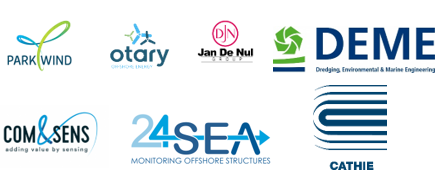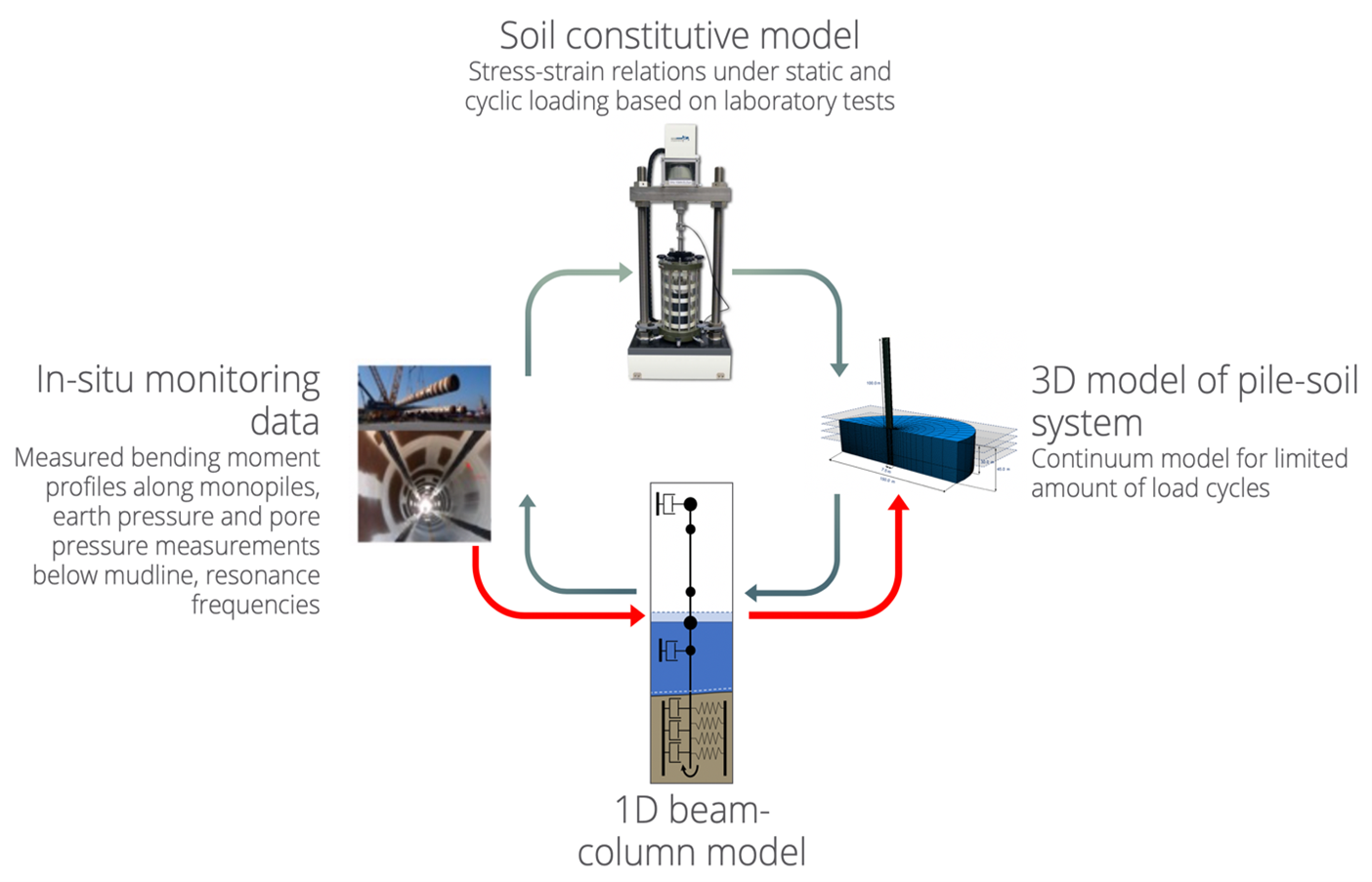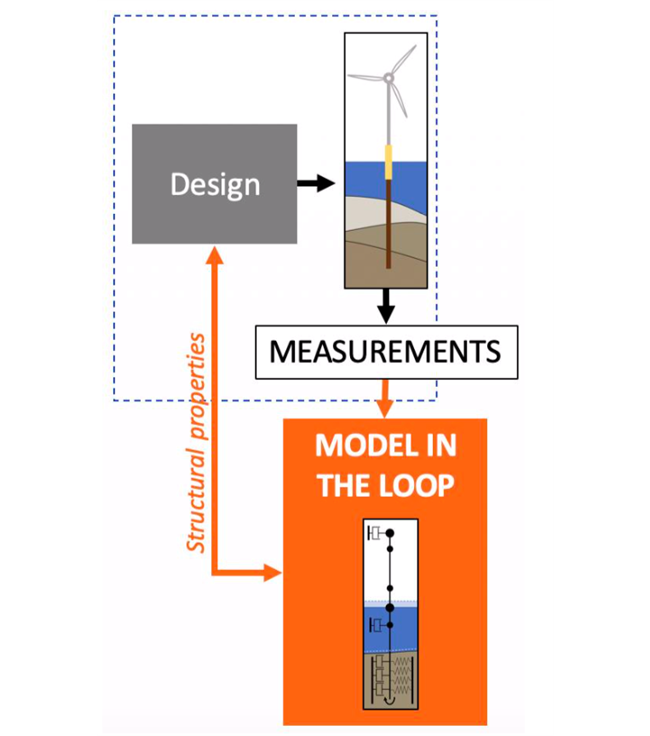Introduction
- Soiltwin: Data driven design optimization and smart monitoring of monopile foundations using updated soil-structure interaction models
- 2 Partners
- Coordinator: Vrije Universiteit Brussel
- Start Date 01/01/2020
- Duration: 4 Years
- Total Budget: € 1.203.947
- Funded by The Blue Cluster
Soiltwin Consortium Partners
VUB, UGent

Industrial advisory board
Parkwind, Otary, Jan De Nul, DEME, 24SEA, COM&SENS, Cathie Associates

Project Context
Today we see an industry-wide mismatch between design expectations and the as built dynamics of offshore wind turbines installed on monopile foundations. This mismatch results in a sub-optimal (fatigue) design and ultimately a higher cost for offshore energy. It is the general consensus of both academia and industry that this is due to errors in the interaction between the monopile and the surrounding soil. Current soil-structure interaction models are not “tuned” to correctly assess the soil stiffness at small displacements for short and large diameter piles, i.e. monopiles.
This project therefore aims to calibrate those models by updating them based on Finite element analysis and lab-experiments at UGent and the Coastal and Ocean Basin (COB) and measurements performed on all Belgian offshore wind turbines. Moreover, the monitoring data will provide insight in the evolution of the soil behaviour during the lifetime of the structure. A unique dataset of monitoring data is already available to the project which includes both geotechnical and structural measurements. This information contained in this dataset needs to be converted to insights in geotechnical and structural behaviour, otherwise the potential of this dataset will not be unlocked.
Project Description
As a first step, the soil behaviour next to monopile foundations will be better characterised through laboratory tests. Soil behaviour under cyclic loading can lead to both softening and stiffening of the response depending on the loading intensity and number of cycles. The aim of the laboratory testing is to better characterise the thresholds at which cyclic degradation will start to occur and which loading regimes could lead to stiffening of the soil response. All in-situ monitoring data indicate stiffening of the overall foundation response over time (increased eigenfrequencies). Based on the laboratory testing, a constitutive model will be calibrated which can explain the soil behaviour for selected episodes of cyclic loading.

The second goal of the project is to calibrate the constitutive model and use it in 3D finite element analyses such that the measured bending moment profiles can be matched. The in-situ measured bending moments at Nobelwind along the pile provide a detailed insight in the soil behaviour next to the pile during high and low intensity loading. The calibrated soil parameters will provide insight in the behaviour of the soil next to the pile and the evolution of soil properties under cyclic loading.
In addition to the in-situ data at Nobelwind, coupled hydrodynamic-geotechnical analyses in the controlled environment of the hydraulic laboratory will also be carried out to further improve the calibration of the models. These analyses support a secondary project goal, which is to improve the readiness of the project partners and the Coastal and Offshore Basin (COB) to perform coupled hydrodynamic-geotechnical tests with appropriate scaling of geotechnical and hydrodynamic properties.
While a sophisticated constitutive model provides detailed insight in soil behaviour, 3D finite element analyses are not well-suited for routine calculations because of their computational expense. Therefore, the project proposes to develop a 1D beam-column model which captures the key trends in the soil response but allows faster calculation of the bending moments and pile deflections. The 1D model will also include base resistance and distributed moment-rotation resistance along the pile which have been shown to be important in recent research.
Continuing from the calibrated 1D beam-column model of the monopile-soil interaction, an integrated ‘digital twin’ model will be created of the entire offshore wind turbine. This model will enable the calculation of the eigenfrequencies of the structure and is a necessary tool for comparison between the measured eigenfrequencies and the modelled values. Any remaining discrepancy between design and measurement for a particular soil type, should be mitigated by further improving the modelling of said soil’s response model. An extensive measurement campaign of the resonance frequencies, using mobile measurement units, in the Belgian offshore zone is planned to validate the results over an as large as possible set of different offshore (monopile) structures.
Finally, a novel fleet-wide model updating strategy will be developed. Each location within a farm will be paired with an updatable digital twin model. Novel to the updating process is to consider fleet wide similarities, e.g. in turbine masses, within the updating. Ultimately, each Digital Twins will be continuously updated to best represent the local conditions, including soil condition, whenever a new measurement of the resonance frequency becomes available. Through the digital twin operators can monitor elemental concerns such as scour and soil degradation and improve their residual fatigue assessments for optimized service life.

Het Soiltwin-project richtte zich op de verbetering van de modellering van de interactie tussen de bodem en de structuur van monopiles voor offshore windturbines. De belangrijkste resultaten van het project omvatten:
-
Verfijning van bodemmateriaalmodellen: Het project heeft 3D numerieke modellen ontwikkeld voor de interactie tussen monopiles en de bodem. Deze modellen zijn geoptimaliseerd door uitgebreide cyclische en quasi-statische tests op Noordzee-gronden. Het gebruik van verbeterde bodemmateriaalmodellen, zoals de PISA-modellen, leidde tot een significante verbetering in het voorspellen van de eigenfrequenties van turbines.
-
Ontwikkeling van digitale tweelingen: Het project heeft digitale tweelingen gecreëerd van de fundaties van offshore windturbines, wat het mogelijk maakt om de reactie van de monopiles op verschillende belastingcondities te simuleren. Dit werd gekoppeld aan een cloudgebaseerd metadatabasesysteem voor het beheer van geotechnische en structurele gegevens.
-
Verbeterde analysemethoden: De projectresultaten verbeterden de nauwkeurigheid van de voorspellingen van de dynamische respons van windturbines, met name met betrekking tot de eigenfrequenties en de impact van verschijnselen zoals schurende bodems en beschermende lagen.
-
Toepassingen voor industriële valorisatie: De ontwikkelde modellen hebben veel potentieel voor de ontwerp- en monitoringfase van offshore windturbines. Specifieke valorisatiecasussen omvatten het gebruik van deze modellen voor de ondersteuning van ontwerpfase (FEED) en levensduurbeoordelingen van monopile-ondersteunde turbines. Het project heeft ook de basis gelegd voor verdere commerciële toepassingen, zoals een licentiemodel voor het gebruik van de ontwikkelde software door geotechnische consultants.


